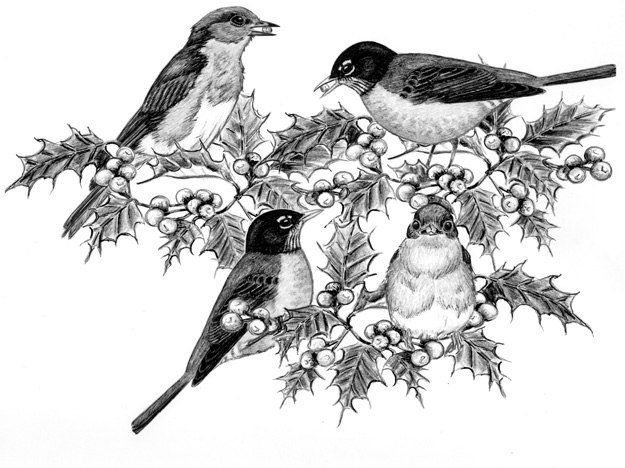
Dear Bird Folks,
In an effort to have a “green,” earth-friendly Christmas, I suggested that my garden club string cranberries on our shrubs instead of power-consuming lights. However, someone in the club dismissed my idea because she said the birds would quickly eat all the cranberries. Would that be a problem? Do birds eat cranberries?
– Cheryl, North Adams, MA
Good for you, Cheryl,
I applaud your efforts to try to save our planet with cranberries. Seriously. At my store I’m always arguing against putting out more Christmas lights. Everyone there calls me “Scrooge,” but I don’t mind; it’s actually one of the nicer names they call me. While I’ve had some success at keeping the light show to a minimum at work, I’ve failed miserably at home. Each year we seem to have another tree, shrub or bush with an extension cord running into it. Last year it was so bad that whenever the space shuttle passed over our house the astronauts had to pull their shades down so they could sleep at night. This year it’s worse.
When I received your note about birds eating cranberries I got a chill. Not only did I not know the answer to your question, but also, if birds really do eat cranberries, how long have I been missing out on this lucrative market? I live in the middle of cranberry central. Could I have been selling expensive, custom-built cranberry birdfeeders all these years and not have known it? I had to find out the answer ASAP. But how?
Since I personally don’t know any cranberry growers, I contacted Ocean Spray, the folks who invented cranberries. I called the consumer hotline, where they claimed they could answer any question about cranberries. Wrong. Cassie, the very nice phone-answering lady, was clueless about this bird thing. She put me on hold three times (apparently to ask the head cranberry honcho). She finally came back and said, “I think so.” What? “I think so” just doesn’t cut it in this rock-solid, fact-filled column. I had to find a better source.
Five minutes after I hung up with Cassie a customer walked in the store. He was just the guy I needed to talk to. (I swear I’m not making this up). The guy was wearing a hat that had “Bog Man” written on it. Wow! How perfect is that? With a name like Bog Man he either owned a cranberry bog or was a creepy character in a spooky movie. I had to find out which, so I yelled, “Yo, Bog Man.” He turned around and smiled. Whew! It turned out that Bog Man indeed owned a cranberry bog and wasn’t creepy at all. (Well, maybe a little.) I asked him about birds eating his berries and he shook his head and said, “Nope.” He said sometimes geese or ducks will eat the plants, but he has never seen a bird eat a single berry. Ah-ha! Wait until I tell Cassie what Bog Man had to say. Her face is going to be red…like a cranberry.
It’s okay to string cranberries around your trees, Cheryl. They’ll be perfectly safe from the birds. But in this season of giving, shouldn’t we be putting out food to help birds instead of food they won’t eat? When I started writing this column I was going offer a list of wild berries that birds like to eat. Then I was going to suggest that we all go out in the woods, gather branches filled with these berries, take them home and incorporate them into a large outdoor display. It would be like a holiday fruit basket for birds. Then it hit me. If we collect wild berries from the woods, we could be removing an important food supply that many birds depend on. So forget that berry gathering idea. That was stupid. Instead, let’s talk about planting bushes and trees that will supply birds with fruit for years to come. Below are suggestions of colorful, native trees and shrubs that will not only brighten up your yard, but will also provided food for birds during a tough time of year.
The first tree on the list is the American holly. This tree has it all going on. It has bright evergreen leaves, beautiful red berries that robins, bluebirds and mockingbirds love and it’s American. With this one tree we can help the birds and be patriotic at the same time. Keep in mind that you’ll need both a female and a male holly tree in order to produce fruit, so don’t cheap out and only buy one. Winterberry, as the name suggests, is another good shrub for birds during the winter. Wintering catbirds and thrashers readily come for the red berries. Inkberry is a hardy bush that produces small black berries that towhees, thrushes and turkeys chow down whenever they can find them. Despite its sinister name, Virginia creeper is actually a very bird friendly vine. Thirty-five bird species eat the tiny, blue berries including woodpeckers, vireos and warblers. But what’s really good about Virginia creeper is that the vines look a little like poison ivy. So it not only attracts birds, but it also helps keep the neighbors out of your yard. That’s a good plant.
Even though this talk of bird-friendly plants is helpful, let’s not forget about the most important way to attract birds to your yard is to buy birdseed, lots and lots of birdseed. After all, this is the season of giving…and shopping. So you’d better be good because you-know-who is watching this time of year. That’s right, the Bog Man could be watching and you don’t want to get him mad. You could end up with cranberries in your stocking and that’s not as much fun as it sounds.